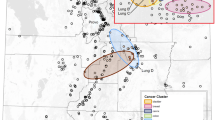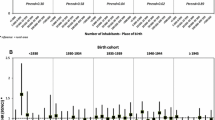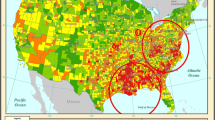Abstract
ObjectiveThis study focused on geographic clustering of breast cancer based on residence in early life and identified spatio-temporal clustering of cases and controls. Methods: Data were drawn from the WEB study (Western New York Exposures and Breast Cancer Study), a population-based case–control study of incident, pathologically confirmed breast cancer (1996–2001) in Erie and Niagara counties. Controls were frequency-matched to cases on age, race, and county of residence. All cases and controls used in the study provided lifetime residential histories. The k-function difference between cases and controls was used to identify spatial clustering patterns of residence in early life. Results: We found that the evidence for clustered residences at birth and at menarche was stronger than that for first birth or other time periods in adult life. Residences for pre-menopausal cases were more clustered than for controls at the time of birth and menarche. We also identified the size and geographic location of birth and menarche clusters in the study area, and found increased breast cancer risk for pre-menopausal women whose residence was within the cluster compared to those living elsewhere at the time of birth. Conclusion: This study provides evidence that early environmental exposures may be related to breast cancer risk, especially for pre-menopausal women.
Similar content being viewed by others
References
SR Sturgeon CG Schairer M McAdams LA Brinton RN Hoover (1995) ArticleTitleGeographic variation in mortality from breast cancer among white women in the United States J Natl Cancer Inst 87 1846–1853
JV Lacey ParticleJr. SS Devesa LA Brinton (2002) ArticleTitleRecent trends in breast cancer incidence and mortality Environ Mol Mutagen 39 82–88
MS Wolff GW Collman C Barrett J Huff (1996) ArticleTitleBreast cancer and environmental risk factors: epidemiologic and experimental findings Annu Rev Pharmacol Toxicol 36 573–596
F Laden DJ Hunter (1998) ArticleTitleEnvironmental risk factors and female breast cancer Annu Rev Public Health 19 101–123
D Kuh Y Ben-Shlomo (1997) A Life Course Approach to Chronic Disease Epidemiology: Tracing the Origins of Ill-health from Early to Later Life Oxford University Press Oxford
DJP Barker (1992) Fetal and Infant Origins of Adult Disease BMJ Publishing London
GA Colditz AL Frazier (1995) ArticleTitleModels of breast cancer show that risk is set by events of early life: prevention efforts must shift focus Cancer Epidemiol Biomarkers Prev 4 567–571
D Trichopoulos (1990) ArticleTitleHypothesis: does breast cancer originate in-utero Lancet 335 939–940
N Potischman R Troisi (1999) ArticleTitleIn-utero and early life exposures in relation to risk of breast cancer Cancer Causes Control 10 561–573
LH Lumey (1998) ArticleTitlePrenatal oestrogens and breast cancer Paediatr Perinat Epidemiol 12 361–365
P Elliott JC Wakefield NG Best DJ Briggs (2000) Spatial Epidemiology: Methods and Applications Oxford University Press Oxford
GDT (2001) GDT Dynamp/2000 Version 11.1, Geographic Data Technology, INC. USA.
BD Ripley (1981) Spatial Statistics Wiley New York
BD Ripley (1977) ArticleTitleModelling spatial patterns J R Stat Soc Ser B 39 172–212
B Rowlingson PJ Diggle (1993) ArticleTitleSPLANCS: spatial point pattern analysis code in S-plus Comput Geosci 19 627–655
PJ Diggle AD Chetwynd (1991) ArticleTitleSecond-order analysis of spatial clustering for inhomogeneous populations Biometrics 47 1155–1163
M Kulldorff N Nagarwalla (1995) ArticleTitleSpatial disease clusters: detection and inference Stat Med 14 799–810
M Kulldorff (1997) ArticleTitleA spatial scan statistic Commun Stat-Theor M 26 1481–1496
TC Bailey AC Gatrell (1995) Interactive Spatial Data Analysis Longman Harlow
LM Timander S McLafferty (1998) ArticleTitleBreast cancer in West Islip, NY: a spatial clustering analysis with covariates Soc Sci Med 46 1623–1636
PA Rogerson D Han (2002) ArticleTitleThe effects of migration on the detection of geographic differences in disease risk Soc Sci Med 55 1817–1828
K McPherson CM Steel JM Dixon (2000) ArticleTitleABC of breast diseases: breast cancer epidemiology, risk factors, and genetics Br Med J 321 624–628
B Stavola R Hardy D Kuh I Sllva M Wadsworth A Swerdlow (2000) ArticleTitleBirthweight, childhood growth and risk of breast cancer in a British cohort Br J Cancer 83 964–968
N Cressie (1993) Statistics for Spatial Data Wiley New York
S Reader (2000) ArticleTitleUsing survival analysis to study spatial point patterns in geographical epidemiology Soc Sci Med 50 985–1000
Snow J (1855) On the mode of communication of cholera. In: Snow on cholera being a reprint of two papers by John Snow, M.D. 1936. New York: The Commonwealth Fund.
K Jones G Moon (1987) Health, Disease, and Society Routledge London
MS Meade JW Florin WM Gesler (1988) Medical Geography Guilford New York
C Dunn S Kingham B. Rowlingson et al. (2001) ArticleTitleAnalysing spatially referenced public health data: a comparison of three methodological approaches Health Place 7 1–12
Author information
Authors and Affiliations
Corresponding author
Rights and permissions
About this article
Cite this article
Han, D., Rogerson, P.A., Nie, J. et al. Geographic clustering of residence in early life and subsequent risk of breast cancer (United States). Cancer Causes Control 15, 921–929 (2004). https://doi.org/10.1007/s10552-004-1675-y
Received:
Accepted:
Issue Date:
DOI: https://doi.org/10.1007/s10552-004-1675-y




